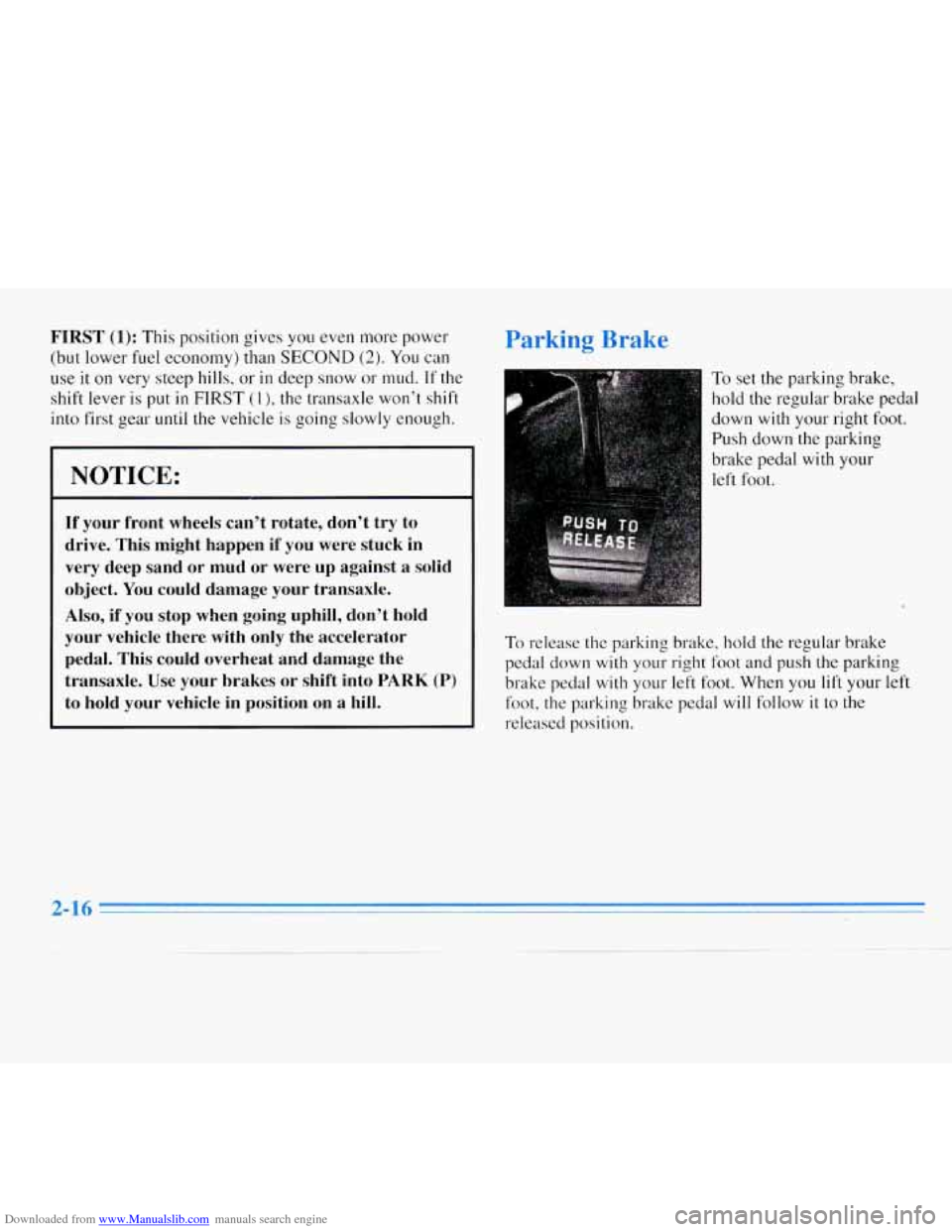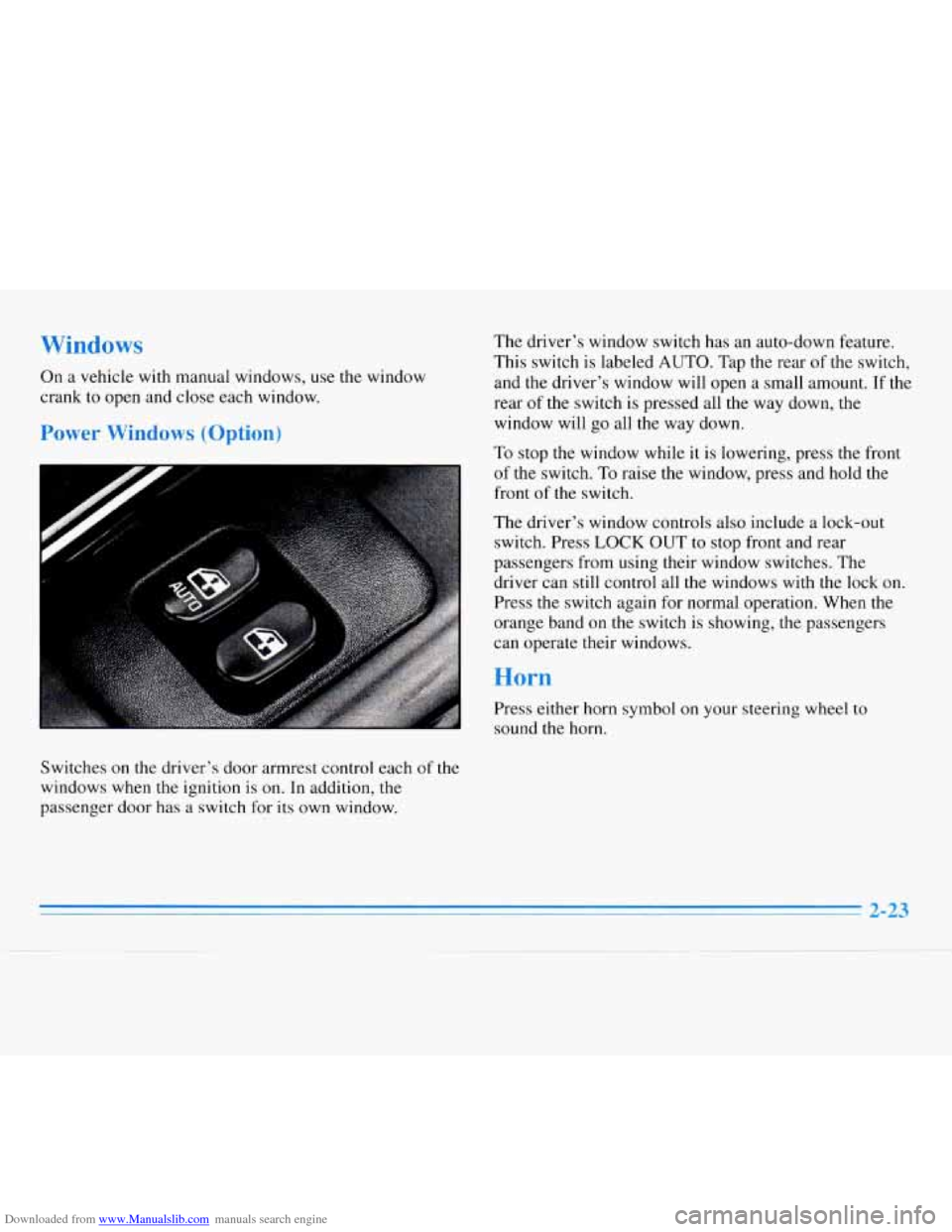Page 71 of 340

Downloaded from www.Manualslib.com manuals search engine Automatic Transaxle Operation
-I
Your automatic transaxle may have a shift lever on the
steering column or on the console between the seats.
Maximum engine speed
is limited on automatic
transaxle vehicles, when you’re
in PARK (P) or
NEUTRAL (N), to protect driveline components from
improper operation.
There are several different positions for your shift lever.
PARK (P): This locks your front wheels. It’s the best
position to use when
you start your engine because your
vehicle can’t move easily.
It is dangerous to get out of your vehicle if the
shift lever
is not fully in PARK (P) with the
parking brake firmly set. Your vehicle can
roll.
Don’t leave your vehicle when the engine is
running unless you have to.
‘If you have left the
engine running, the vehicle can move suddenly.
You
or others could be injured. To be sure your
vehicle won’t move, even when you’re on fairly
level ground, always set your parking brake and
move the shift lever to
PARK (P).
See (‘Shifting Into PARK (P)” in the Index. If
you’re pulling a trailer, see “Towing a Trailer” in
the Index.
Make sure the shift lever is fully into PARK (P) range
before starting the engine. Your Chevrolet has
a
brake-transaxle shift interlock. You must fully apply
your regular brakes before you can shift from PARK (P)
when the ignition is
in RUN. If you cannot shift out of
PARK (P), ease pressure on the shift lever by pushing it
all the way into PARK (P) while keeping the brake pedal
- 2-13
Page 72 of 340

Downloaded from www.Manualslib.com manuals search engine pushed down. Release the shift lever button if you
have a console shift. Then move the shift lever out of
PARK (P), being sure to press the shift lever button
if you have
a console shift. See “Shifting Out of
PARK (P)” in the Index.
REVERSE (R): Use this gear to back up.
I NOTICE:
Shifting to REVERSE (R) while your vehicle is
moving forward could damage your transaxle.
Shift to REVERSE (R) only after your vehicle
is stopped.
To rock your vehicle back and forth to get out of snow,
ice or sand without damaging your transaxle, see
“Stuck: In Sand, Mud, Ice
or Snow” in the Index.
NEUTRAL (N): In this position, your engine
doesn’t connect with the wheels.
To restart when you’re
already moving, use NEUTRAL
(N) only. Also, use
NEUTRAL (N) when your vehicle is being towed.
I
-1
Shifting out of PARK (P) or NEUTRAL (N) while
your engine
is “racing” (running at high speed) is
dangerous. Unless your foot is firmly on the
brake pedal, your vehicle could move very
rapidly. You could lose control and hit people or
objects. Don’t shift out of PARK
(P) or
NEUTRAL
(N) while your engine is racing.
I NOTICE:
Damage to your transaxle caused by shifting out
of PARK (P) or NEUTRAL (N) with the engine
racing isn’t covered
by your warranty.
2-14
Page 74 of 340

Downloaded from www.Manualslib.com manuals search engine FIRST (1): This position gives you even more power
(but lower fuel economy) than
SECOND (2). You can
use it
on very steep hills, or in deep snow or mud. If the
shift lever
is put in FIRST (l), the transaxle won’t shift
into first gear until the vehicle is going slowly enough.
I NOTICE:
~~~~~ ~
If your front wheels can’t rotate, don’t try to
drive.
This might happen if you were stuck in
very deep sand or mud or were up against a solid
object.
You could damage your transaxle.
Also, if you stop when going uphill, don’t hold
your vehicle there with only the accelerator
pedal. This could overheat and damage the
transaxle. Use your brakes or shift into PARK (P)
to hold your vehicle in position on a hill.
Pa
To set the parking brake,
hold the regular brake pedal
down
with your right foot.
Push down the parking
brake pedal
with your
left foot.
To release the parking brake, hold the regular brake
pedal down
with your right foot and push the parking
brake pedal
with your left ,foot. When you lift your left
foot, the parking brake pedal will follow
it to the
released position.
2-16
Page 81 of 340

Downloaded from www.Manualslib.com manuals search engine On a vehicle with manual windows, use the window
crank
to open and close each window.
Switches
on the driver’s door armrest control each of the
windows when the ignition is on. In addition,
the
passenger door has a switch for its own window. The
driver’s window switch has an auto-down feature.
This switch
is labeled AUTO. Tap the rear of the switch,
and the driver’s window will open a small amount. If the
rear of the switch
is pressed all the way down, the
window will go all the way down.
To stop the window while it is lowering, press the front
of the switch. To raise the window, press and hold the
front of the switch.
The driver’s window controls also include a lock-out
switch. Press
LOCK OUT to stop front and rear
passengers from using their window switches. The
driver can still control all
the windows with the lock on.
Press the switch again for normal operation. When the
orange band on
the switch is showing, the passengers
can operate their windows.
’Torn
Press either horn symbol on your steering wheel to
sound the horn.
Page 82 of 340
Downloaded from www.Manualslib.com manuals search engine Tilt Steering Wheel Turn SignaVMultifunction Lever
A tilt steering wheel allows
you to adjust the steering
wheel before you drive. You
can also raise it to the
highest level to give your
legs more room when you
exit and enter the vehicle.
To tilt the wheel, hold the steering wheel and pull the
lever.,
Movg the steering wheel to a comfortable level,
then release the lever to lock the wheel
in place.
.L I
The 'lever on the left side of the steering column
includes
yoyr:,
6
0
0
0
0
Turn Signal and Lane Change Indicator
Headlamp HigWLow
Beam
Windshield Wipers
Windshield Washer
Cruise Control (Option)
Page 85 of 340
Downloaded from www.Manualslib.com manuals search engine Cruise Control (Option)
Cruise control can be dangerous where you
can’t drive safely at a steady speed.
So,
don’t use your cruise control on winding
roads or in heavy traffic.
slippery roads. On such roads, fast changes
in tire traction can cause needless wheel
spiming, and you could lose control. Don’t
use cruise control
on slippery roads.
Cruise control can be dangerous on
With cruise control, you can maintain a speed of about
25 mph (40 kmdh) or more without keeping your foot on
the accelerator. This can really help on long trips. Cruise
control does not work at speeds below about
25 mph
(40 kmh).
When you apply your brakes, the cruise control shuts
off.
2-27
Page 132 of 340

Downloaded from www.Manualslib.com manuals search engine Steering Wheel Controls (Option)
If your vehicle has this feature, you can control certain
radio functions using the buttons
on your steering wheel.
VOLUME: Press the up arrow to increase the volume
and the down arrow to decrease volume,
PLAY Press this button to play a cassette tape or
compact disc when the radio is playing.
MUTE: Press this button to silence the system. Press it
again to turn on the sound.
SEEK: Press the up arrow to tune to the next radio
station and the down arrow to tune to
the previous radio
station.
If a cassette tape or compact disc is playing, the
player will advance with the up arrow and rewind with
the down arrow.
PRESET: Press this button to play a station you have
programmed on the radio preset buttons.
AM-FM: Press this button to choose AM, FM1 or
FM2. If a cassette tape or compact disc is playing, it will
stop and the radio will play.
derstanding Radio Reception
Stereo
FM stereo will give you the best sound. But FM signals
will reach only about
10 to 40 miles (16 to 65 km). Tall
buildings or hills can interfere with
FM signals, causing
the sound to come and
go.
AM
The range for most AM stations is greater than for FM,
especially at night. The longer range, however, can
cause stations
to interfere with each other. AM can pick
up noise from things like storms and power lines. Try
reducing the treble
to reduce this noise if you ever get it.
Tips About Your Audio System
Hearing damage from loud noise is almost undetectable
until it is too late. Your hearing can adapt to higher
volumes of sound. Sound that seems normal can be loud
and harmful to your hearing. Take precautions by
adjusting
the volume control on your radio to a safe
sound level before your hearing adapts to
it.
3-20
Page 143 of 340
Downloaded from www.Manualslib.com manuals search engine The anti-lock system can change the brake pressure faster
than any driver could. The computer
is programned to
make the most
of available tire and road conditions.
Here’s how anti-lock works. Let’s say the road is wet.
You’re driving safely. Suddenly an animal
jumps out in
front of you.
You slam on the brakes. Here‘s what happens with ABS.
A computer senses that wheels are slowing down. If one
of the wheels is about to stop rolling, the computer will
separately work the brakes at each front wheel and at the
rear wheels.
You can steer around the obstacle while braking hard.
As you brake, your computer keeps receiving updates on
wheel speed and controls braking pressure accordingly.